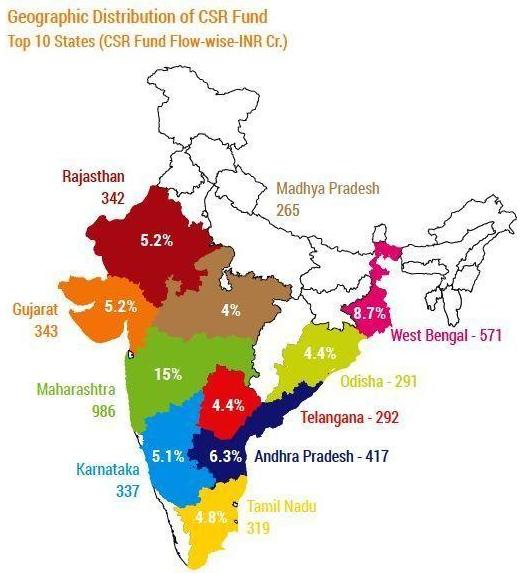Share of Maharashtra, Rajasthan and Jharkhand in corporate social responsibility (CSR) funds declined in 2016, according to India CSR Outlook Report (ICOR) 2016. While Maharashtra still holds the first position in the list, all three states saw a huge decline in CSR expenditure.
ICOR is an analysis of CSR spending of Bombay Stock Exchange (BSE) listed 250 companies compiled by NGOBox. The report was launched at India CSR Summit in Mumbai.

Image Courtesy: ICOR 2016
According to ICOR, CSR contribution in Rajasthan was at Rs 552 crore in 2015 holding 10% of the total expenditure whereas in 2016, the amount spent was Rs 342 crore with mere 5.2% share. Maharashtra received funds worth Rs 1,012 crore holding share of 18% from the total CSR spending in the country. However, in 2016, the amount dropped down to Rs 986 crore with a share of 15% from the national CSR expenditure. Jharkhand, in 2015 was listed in the top 10 states receiving most CSR funds with 6% share. However, this year, Jharkhand is not on the list.
“Most corporate offices are in Mumbai and such metropolitan cities. Thus most CSR activities are done in industrial states. But now people are realising the need and accordingly changing their strategies,” said Vijay Ganapathy, COO, ThinkThrough Consulting Pvt Ltd, a CSR consultancy firm.
States like West Bengal, Andhra Pradesh and Madhya Pradesh stepped up the list attracting more CSR expenditure. West Bengal and Andhra Pradesh as compared to last year’s Rs 205 crore and Rs 176 crore CSR expenditure respectively, saw a whopping Rs 571 crore and Rs 417 crore expenditure in 2016. Madhya Pradesh became the new entrant in the top 10 list with Rs 265 crore being spent there.
Contributions received by Maharashtra, West Bengal and Andhra Pradesh together sum up for one fourth of India’s total CSR Fund. These states being industrial attract more funds leaving the other states behind.
While most states in the list of top-10 states have retained their positions, northern and north-eastern states are still struggling to gain their spots. All the bottom five states in ICOR 2015 were from north-east India. This part of the country has been demanding development for a long time but most companies tend to spend more in their surrounding areas as guided by the law.
State-wise CSR expenditure statistics of last year raised many discussions about the need of development funds in backward states. Many not-for-profit organisations asked for funds being used there. But geographical distance and lack of enough industries play important role in lesser spending in these areas.
State governments can probably play an important role in bridging this gap. “Although north-eastern states do not have many industries, but they are huge markets for many companies. State governments here can prepare and provide a conducive structure and ecosystem for companies to invest in CSR. They need to create an awareness that these states require funds. If state governments create CSR cells like states of Gujarat and Maharashtra, whereby firms can connect to genuine NGOs with needed clearances, CSR funds can be attracted.
As per the ICOR 2016, there has been substantial rise in the CSR expenditure in the second year of mandate implementation. The data from 2015-16 suggests an increase in adherence to the documentation guidelines and a substantial increase from 79% in 2014-15 to 92% of actual CSR spend to the prescribed CSR. About one-third of the companies have spent more than the mandated CSR fund suggesting that the companies who were doing social good and spending substantial fund on CSR before the mandatory CSR regime still continues doing the same with pushing the boundaries further for the good of communities.
Bhomik Shah, CEO and Founder of NGOBox said, “We see a lot of improvement both at quantitative and qualitative fronts in CSR spend. Instead of smaller projects spreading in many areas, companies are now focusing on bigger and impactful CSR programmes. On CSR spend side, 58% companies spent equal or more than the prescribed CSR in 2015-16, this is a substantial increase from 44% in 2014-15.”
Education and Skills attracted the highest CSR funds followed by poverty alleviation, healthcare and WASH. Benefits to Armed Forces veterans, war widows, Technology Incubation within academic institutions and Urban Slum Development were the categories with least CSR funds.
Thank you for reading the story until the very end. We appreciate the time you have given us. In addition, your thoughts and inputs will genuinely make a difference to us. Please do drop in a line and help us do better.
Regards,
The CSR Journal Team
